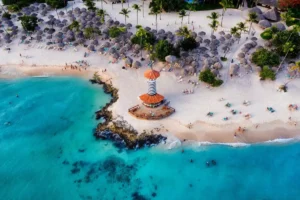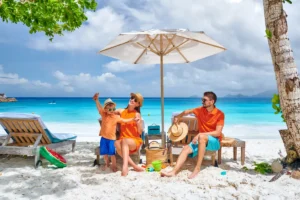If you are a discerning traveler, seeking not only luxury and comfort but also a deep connection with nature, then the Dominican Republic offers you a botanical paradise. Indeed, beyond its dreamlike beaches and attractive culture, the country is home to exceptional biodiversity. For this reason, the native plants of the Dominican Republic hold a prominent place on its visitors’ agendas.
Immerse yourself with us in a journey through the unique flora of the island, a faithful natural Eden that invites you to explore and protect. Here, you will find everything from exotic orchids to ancient trees. In fact, each species tells a story of evolution and resilience, ultimately giving you more than just a simple trip.
The richness of the native plants of the Dominican Republic
The Dominican Republic, located in the heart of the Caribbean, is part of the island of Hispaniola, a global biodiversity hotspot. Moreover, this privileged geographical position combines with a varied topography, which includes everything from arid coastal zones to high mountain systems. Consequently, it has managed to maintain an exceptionally diverse flora.
The native plants of the Dominican Republic are more than an aesthetic component of the landscape; in reality, they are the foundation of its ecosystems, essential for wildlife, and an invaluable genetic treasure. Experts estimate that the island is home to thousands of species of vascular plants. A significant percentage of them are endemic, meaning they are not found anywhere else on the planet.
Indeed, the local endemism is a testament to the island’s geological history and its isolation. Each native plant, from the tiniest herbs to the majestic trees, plays a crucial role in the ecological balance. Specifically, they:
- Contribute to climate regulation.
- Protect the soil against erosion.
- Sustain a wide range of fauna.
Without a doubt, knowing and appreciating these species is fundamental for any traveler who wishes to understand the true natural essence of the country and contribute to its conservation.
Native plants of the Dominican Republic: the emblematic species
Among the vast diversity of local fauna, some species stand out for their beauty, uniqueness, or cultural and ecological importance. Therefore, getting to know them will allow you to appreciate the botanical richness that surrounds you even more.
Below, we provide a list of some of the jewels that make up the rich Dominican flora. Each has adapted to its microclimates and, in turn, plays an irreplaceable role in the country’s ecological tapestry.
Dominican flora
Get a preview of them with the following details:
- Rose of Bayahíbe (Pereskia quisqueyana): This is the National Flower of the Dominican Republic, a cactus with the unique feature of having leaves. It is a rare and endemic species, found mainly in the Bayahíbe area. Its pale pink flower is delicate and beautiful, and its existence underscores the uniqueness of the island’s flora.
- Mahogany (Swietenia mahagoni): This is another of the native plants of the Dominican Republic. Although not exclusive to the country, mahogany is the National Tree and a symbol of the island. Its wood, with a beautiful reddish hue, is highly valued for its durability and beauty. However, its exploitation has led it to become a protected species.
- Royal Palm (Roystonea hispaniolana): This is an imposing palm, an icon of the Dominican landscape. With its slender trunk and leafy crown, the Royal Palm beautifies the coasts and plains. At the same time, it provides food and shelter for various species of birds and other animals.
- Hispaniolan Pine (Pinus occidentalis): In the mountainous areas, especially in the Cordillera Central, the Hispaniolan pine is one of the most representative native plants of the Dominican Republic. Its presence is vital for high-altitude ecosystems, and local communities have traditionally used its resin.
- Maguey (Agave antillarum): This plant is present in the country’s arid and semi-arid zones. It is a resilient plant that stands out for its long, pointed leaves. People have used it ancestrally to obtain fibers, and its traditional uses persist in rural areas.
- Native orchids: The Dominican landscape is home to an impressive variety of orchids, many of them endemic. These exquisite flowers, which grow on trees or rocks, display an astonishing diversity of forms and colors. Truly, they are a delight for botany enthusiasts.
Botanical secrets: adaptation and traditional uses in local flora
The resilience of the native plants of the Dominican Republic is astonishing. For instance, numerous species have developed ingenious adaptations to thrive in extreme microclimates, such as in arid areas where water is scarce or in cloud forests with constant humidity.
Beyond their aesthetic beauty and ecological role, many of these species have historically been vital sources of knowledge and resources for local communities. In particular, Dominican folk wisdom has explored their medicinal properties, as people used them in ancestral home remedies, and their fibers or woods in traditional Dominican craftsmanship.
Ultimately, each leaf and stem of these native plants of the Dominican Republic holds ancestral secrets and an invaluable contribution to the country’s rich cultural and biological heritage.
The native plants of the Dominican Republic in their natural habitat
To truly appreciate the native plants of the Dominican Republic, it is essential to explore their diverse natural habitats. The island’s geography offers a range of ecosystems. In turn, each one houses a unique plant community adapted to specific conditions. Below, you can get to know the most representative ones in the country.
The green world you must know
Each of the following landscapes offers a unique opportunity to connect with nature:
- Humid and cloud forests: Mountainous areas like the Cordillera Central and the Sierra de Bahoruco are home to the densest and most humid forests. Here, the vegetation is exuberant, with a profusion of ferns, mosses, bromeliads, and orchids covering the tree trunks. The constant fog and high rainfall create an ideal microclimate for species that require high moisture.
- Dry forests and arid zones: In contrast, the country’s southwest and northwest regions feature dry forests and semi-desert areas, where cacti, agaves, and thorny shrubs dominate. These native plants of the Dominican Republic have developed surprising adaptations to survive with little water, such as modified leaves and succulent stems.
- Mangroves and coastal wetlands: The Dominican coasts are bordered by extensive mangroves. These are vital plant formations that protect the coastal areas from erosion and serve as nurseries for numerous marine species. Red, black, white, and buttonwood mangroves are the predominant species, with intertwined aerial roots that form complex ecosystems.
- Pine forests: At high altitudes, you can find pine forests, dominated by the Hispaniolan pine. These coniferous forests offer a different landscape, with an undergrowth of herbs and shrubs that have adapted to rocky soils and cooler climates.
- Valleys and plains: These are vast extensions that host a diversity of plants, many of them adapted to agriculture and livestock. However, they also preserve remnants of native flora in less-intervened areas, including fruit and ornamental trees.
If you want to explore more about the conservation of biodiversity in the country, you can consult initiatives like those of the United Nations Development Programme.
Conservation and experiences: protecting the local flora
Protecting the native plants of the Dominican Republic must be a priority. This not only ensures the health of the ecosystems but also the future of the island’s biodiversity. For this reason, the government, non-governmental organizations, and civil society are working on conservation initiatives. Below, we invite you to discover some of them:
- Protected areas: The country has an extensive network of protected areas. These include national parks, scientific reserves, and natural monuments, such as the Salto de Socoa Natural Monument. These spaces are vital for the preservation of flora and fauna and, in addition, offer opportunities for responsible ecotourism.
- Botanical gardens: The National Botanical Garden of Santo Domingo is a key institution in the research, conservation, and education about the native plants of the Dominican Republic. Here, you can find collections of endemic plants, participate in educational programs, and learn about the importance of their protection.
- Ecotourism and awareness: By choosing sustainable tourism experiences, you contribute directly to conservation. For example, hiking trails in national parks, bird watching, or visiting reforestation initiatives are ways to appreciate nature without negatively impacting it.
- Environmental education: Some programs seek to raise awareness among the local population and visitors about the richness of the flora and the need to protect it. For instance, by educating about the illegal extraction of species, not leaving trash, and respecting park regulations.
As a traveler, you have a fundamental role. Therefore, by opting for responsible tour operators and respecting the natural environment, you become an ally in the conservation of this heritage.
Homebelike: connect with nature and luxury in the Dominican Republic
We know that your trip to the Dominican Republic is a search for authentic and exclusive experiences. Our philosophy goes beyond simple accommodation. Therefore, we want you to immerse yourself in the exciting Dominican culture and, of course, in its impressive natural richness.
Imagine complementing a day of exploration among the native plants of the Dominican Republic with the sophistication of our properties. For example, would you like to organize a guided excursion to a natural monument, followed by a private dinner prepared by a local chef? Our specialists are ready to design an itinerary that combines your passion for nature with high-end experiences.
Live a high-level experience in the Dominican Republic
Our inventory of properties in various destinations on the island will allow you to combine multiple attractions. You can choose from the serenity of a mountain retreat with endemic vegetation to the vibrancy of a coastal villa. In short, find your ideal home for this vacation at Homebelike.
On the other hand, if you are looking for inspiration to have new adventures, we invite you to immerse yourself in our personalized experiences. This is an ideal proposal for a first-class trip. Exploring the native plants of the Dominican Republic is a privilege and an opportunity to connect deeply with the essence of this Caribbean paradise. With Homebelike, your botanical adventure merges with comfort and luxury. So, don’t wait any longer to create memories that will last long after you return home.
References
- Conciencia Ambiental. (2025, May 23rd). Descubre la biodiversidad única de la República Dominicana.
- Ministerio de Medio Ambiente y Recursos Naturales de la República Dominicana. (2025). Flora.



